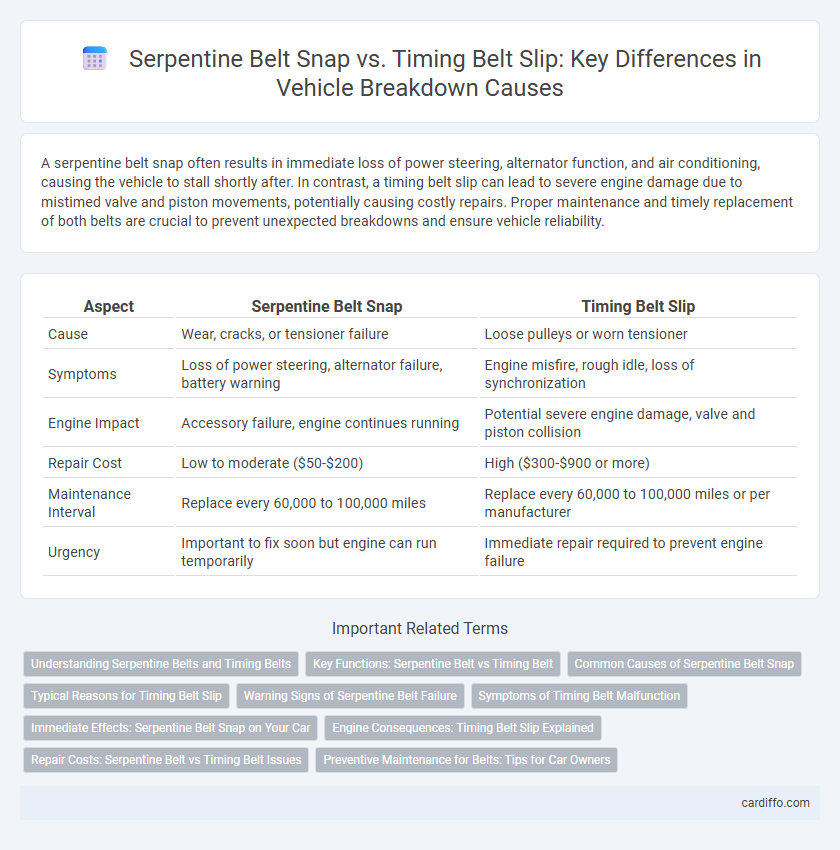A serpentine belt snap often results in immediate loss of power steering, alternator function, and air conditioning, causing the vehicle to stall shortly after. In contrast, a timing belt slip can lead to severe engine damage due to mistimed valve and piston movements, potentially causing costly repairs. Proper maintenance and timely replacement of both belts are crucial to prevent unexpected breakdowns and ensure vehicle reliability.
Table of Comparison
| Aspect | Serpentine Belt Snap | Timing Belt Slip |
|---|---|---|
| Cause | Wear, cracks, or tensioner failure | Loose pulleys or worn tensioner |
| Symptoms | Loss of power steering, alternator failure, battery warning | Engine misfire, rough idle, loss of synchronization |
| Engine Impact | Accessory failure, engine continues running | Potential severe engine damage, valve and piston collision |
| Repair Cost | Low to moderate ($50-$200) | High ($300-$900 or more) |
| Maintenance Interval | Replace every 60,000 to 100,000 miles | Replace every 60,000 to 100,000 miles or per manufacturer |
| Urgency | Important to fix soon but engine can run temporarily | Immediate repair required to prevent engine failure |
Understanding Serpentine Belts and Timing Belts
Serpentine belts drive multiple engine accessories such as the alternator, power steering pump, and air conditioning compressor, making a snap a sudden mechanical failure that can disable these functions immediately. Timing belts synchronize the engine's camshaft and crankshaft, with a slip causing misalignment that leads to poor engine performance or severe internal damage if not addressed promptly. Understanding the distinct roles and failure modes of serpentine and timing belts is crucial for effective vehicle maintenance and avoiding costly repairs.
Key Functions: Serpentine Belt vs Timing Belt
The serpentine belt drives essential accessories such as the alternator, power steering pump, and air conditioning compressor, ensuring smooth vehicle operation. A snap in the serpentine belt causes loss of these functions immediately but rarely damages the engine itself. In contrast, the timing belt synchronizes the engine's camshaft and crankshaft; its slip or failure can result in severe engine damage due to misalignment of valves and pistons.
Common Causes of Serpentine Belt Snap
Serpentine belt snap often results from wear and tear due to prolonged exposure to heat, oil contamination, or cracked, frayed belts causing sudden failure. Misaligned pulleys or a faulty automatic belt tensioner increase stress on the serpentine belt, accelerating damage and potential snapping. Regular inspections can identify early signs such as squealing noises or visible belt wear, preventing breakdowns caused by serpentine belt failure.
Typical Reasons for Timing Belt Slip
Timing belt slip often occurs due to worn or damaged tensioners, oil contamination, or misaligned pulleys that reduce proper belt grip and synchronization. Unlike a serpentine belt snap, which results from cracks or age-related wear causing an immediate break, timing belt slippage primarily stems from insufficient tension or lubrication issues that impair engine timing. Poor maintenance and failure to replace belts at recommended intervals significantly increase the risk of timing belt slip, leading to potential engine damage or misfires.
Warning Signs of Serpentine Belt Failure
Warning signs of serpentine belt failure include squealing noises from the engine, visible cracks or fraying on the belt surface, and loss of power steering or alternator function. Unlike timing belt issues that cause engine misfires or a complete stall, serpentine belt problems primarily affect accessory components. Identifying these symptoms early can prevent breakdowns and costly repairs.
Symptoms of Timing Belt Malfunction
Symptoms of timing belt malfunction include engine misfires, rough idling, and difficulty starting the vehicle. A slipping timing belt can cause noticeable loss of engine power and unusual noises such as ticking or rattling from the engine. Ignoring these signs may lead to severe engine damage, as the timing belt controls crucial synchronization between the crankshaft and camshaft.
Immediate Effects: Serpentine Belt Snap on Your Car
A serpentine belt snap causes an immediate loss of power steering, alternator function, and air conditioning, leading to a rapid decline in vehicle control and battery charge. Unlike a timing belt slip, this break does not typically result in engine timing issues but demands urgent repair to prevent overheating and battery failure. The sudden failure compromises essential systems, making it hazardous to continue driving.
Engine Consequences: Timing Belt Slip Explained
A timing belt slip disrupts the precise synchronization between the crankshaft and camshaft, causing engine misfires, reduced power, and potential valve damage. Unlike a serpentine belt snap that affects accessory functions like power steering and alternator operation, timing belt slippage can lead to severe internal engine damage, including piston and valve collisions. Early detection of timing belt slip through unusual engine noises or performance issues is critical to prevent costly repairs and engine failure.
Repair Costs: Serpentine Belt vs Timing Belt Issues
Repair costs for a serpentine belt snap typically range between $100 and $200 due to the belt's accessibility and simpler replacement process. Timing belt issues, such as slipping, often incur higher expenses, from $500 to $1,000 or more, because of the labor-intensive procedure and the risk of engine damage. The timing belt replacement may also require additional parts like tensioners and water pumps, increasing overall repair costs significantly.
Preventive Maintenance for Belts: Tips for Car Owners
A serpentine belt snap typically causes immediate loss of power steering, alternator, and air conditioning, requiring urgent replacement to prevent engine damage. Timing belt slip, often due to wear or improper tension, can lead to severe engine misfires or catastrophic failure, making timely inspection and replacement crucial. Regularly checking belt tension, visual wear, and following manufacturer guidelines for replacement intervals are essential preventive maintenance practices for car owners to avoid costly breakdowns.
Serpentine belt snap vs timing belt slip Infographic

 cardiffo.com
cardiffo.com